A Review of Energy Loss Reduction Technologies for Internal Combustion Engines to Improve Brake Thermal Efficiency
Abstract
- ➢
- The minimization of heat loss, exhaust energy loss, and friction loss are critical to breaking through the bottleneck of maximum thermal efficiency;
- ➢
- Laser surface texturing, diamond-like carbon, thermal barrier coatings, and nano-lubricant additives are promising technologies for the reduction of engine energy losses;
- ➢
- Advanced variable controllers and variable displacement oil pumps are beneficial for minimizing energy losses.
1. Introduction
2. Low-Friction Technology
2.1. Low-Friction Piston Ring–Liner (PRL) Interaction
2.2. Low-Friction Bearings and Valve Trains
2.3. Improvement of Lubricants System
3. Technologies of Pumping Loss Reduction
4. Low-Cooling-Loss Technologies
5. Energy Distribution and Efficiency in Modern ICEs
6. Conclusions
- Tribological technology supports the study of various lubrication and friction phenomena of the moving parts involved, by optimizing structural design as well as material and surface conditions, achieving both reduced friction coefficient and increased wear resistance. However, low-friction solutions should be balanced with system reliability, since the reduction in viscosity conceals a trap as regards reliability according to lubrication regimes classified by the Stribeck curve;
- Novel anti-friction coating technologies intended for tribological components are expected to be a promising approach for the improvement of the tribo-characteristics of piston ring–liner (PRL) assemblies and valvetrain systems. Laser surface texturing (LST) contributes to great reductions in frictional losses by creating high-density micro-dimples on the PRL’s worn surface. Meanwhile diamond-like carbon (DLC) coatings on PRL and valvetrain systems are impressive for their low friction, high wear resistance, and strong corrosion resistance. Furthermore, nano-lubricants with hybrid nanomaterial additives are attracting great interest for their potential to upgrade the tribological properties by forming protective films on surfaces, while creating a rolling effect between sliding surfaces;
- Advanced variable controllers make the engine working process more flexible, in order to achieve the best possible thermal efficiency. Variable-valve systems, by varying the opening–closing timing, opening lift magnitude, and opening period of valves, are able to mitigate the pumping loss caused by gas exchange and mass flow pulsations. In addition, variable displacement oil pumps and electronic water pumps provide moderate flow of medium based on actual engine demand, without additional pumping work output, thus reducing mechanical loss;
- Thermal management enables an optimized balance between engine thermal load, cabin condition, catalyst light-off, and combustion performance. The new concept of “temperature swing heat insulation” (TSHI) with low-heat-capacitance thermal barrier coatings (TBCs) was successful in facilitating fluctuations in the wall temperature and swinging the gas temperature throughout the cycle, enabling reduction in heat loss without intake air heating. Meanwhile, thermal management intelligent systems (THEMIS) are efficient in coordinating various cooling system components to achieve efficiency targets.
Author Contributions
Funding
Data Availability Statement
Conflicts of Interest
References
- BP. Statistical Review of World Energy. BP Magazine, June 2018. Available online: https://www.bp.com/en/global/corporate/energy-economics/statistical-review-of-world-energy.html (accessed on 10 July 2021).
- Reitz, R.D.; Ogawa, H.; Payri, R.; Fansler, T.; Kokjohn, S.; Moriyoshi, Y.; Agarwal, A.K.; Arcoumanis, D.; Assanis, D.; Bae, C.; et al. The future of the internal combustion engine. Int. J. Engine Res. 2020, 21, 3–10. [Google Scholar] [CrossRef]
- Chart Library: Passenger Vehicle Fuel Economy. Available online: https://theicct.org/chart-library-passenger-vehicle-fuel-economy (accessed on 10 July 2021).
- Awad, O.I.; Ma, X.; Kamil, M.; Ali, O.M.; Zhang, Z.; Shuai, S. Particulate emissions from gasoline direct injection engines: A review of how current emission regulations are being met by automobile manufacturers. Sci. Total Environ. 2020, 718, 137302. [Google Scholar] [CrossRef]
- Zacharof, N.; Fontaras, G.; Ciuffo, B.; Tansini, A.; Prado-Rujas, I. An estimation of heavy-duty vehicle fleet CO2 emissions based on sampled data. Transp. Res. Part D Transp. Environ. 2021, 94, 102784. [Google Scholar] [CrossRef]
- Trucks and Buses. Available online: https://www.iea.org/reports/trucks-and-buses (accessed on 10 July 2021).
- Reducing CO2 Emissions from Heavy-Duty Vehicles. Available online: https://ec.europa.eu/clima/policies/transport/vehicles/heavy_en (accessed on 10 July 2021).
- Rakopoulos, C.D.; Giakoumis, E.G. Second-law analyses applied to internal combustion engines operation. Prog. Energy Combust. Sci. 2006, 32, 2–47. [Google Scholar] [CrossRef]
- Caton, J.A. Maximum efficiencies for internal combustion engines: Thermodynamic limitations. Int. J. Engine Res. 2018, 19, 1005–1023. [Google Scholar] [CrossRef]
- Razmara, M.; Bidarvatan, M.; Shahbakhti, M.; Robinett III, R.D. Optimal exergy-based control of internal combustion engines. Applied Energy 2016, 183, 1389–1403. [Google Scholar] [CrossRef][Green Version]
- Liu, H.; Ma, J.; Tong, L.; Ma, G.; Zheng, Z.; Yao, M. Investigation on the Potential of High Efficiency for Internal Combustion Engines. Energies 2018, 11, 513. [Google Scholar] [CrossRef]
- Yao, Z.M.; Qian, Z.Q.; Li, R.; Hu, E. Energy efficiency analysis of marine high-powered medium-speed diesel engine base on energy balance and exergy. Energy 2019, 176, 991–1006. [Google Scholar] [CrossRef]
- Feneley, A.J.; Pesiridis, A.; Andwari, A.M. Variable geometry turbocharger technologies for exhaust energy recovery and boosting-A Review. Renew. Sustain. Energy Rev. 2017, 71, 959–975. [Google Scholar] [CrossRef]
- Zhao, X.; Qiu, L.; Wei, K.; Zhang, Z.; Deng, Y.; Han, D.; Liu, G. Experimental investigation on performance and economy characteristics of a diesel engine with variable nozzle turbocharger and its application in urban bus. Energy Convers. Manag. 2019, 193, 149–161. [Google Scholar] [CrossRef]
- Zhu, S.; Zhang, K.; Deng, K. A review of waste heat recovery from the marine engine with highly efficient bottoming power cycles. Renew. Sustain. Energy Rev. 2019, 120, 109611. [Google Scholar] [CrossRef]
- Xu, B.; Rathod, D.; Yebi, A.; Filipi, Z.; Onori, S.; Hoffman, M. A comprehensive review of organic rankine cycle waste heat recovery systems in heavy-duty diesel engine applications. Renew. Sustain. Energy Rev. 2019, 107, 145–170. [Google Scholar] [CrossRef]
- Wakisaka, Y.; Inayoshi, M.; Fukui, K.; Kosaka, H.; Hotta, Y.; Kawaguchi, A.; Takada, N. Reduction of Heat Loss and Improvement of Thermal Efficiency by Application of “Temperature Swing” Insulation to Direct-Injection Diesel Engines. SAE Int. J. Engines 2016, 9, 1449–1459. [Google Scholar] [CrossRef]
- Kawaguchi, A.; Wakisaka, Y.; Nishikawa, N.; Kosaka, H.; Yamashita, H.; Yamashita, C.; Iguma, H.; Fukui, K.; Takada, N.; Tomoda, T. Thermo-swing insulation to reduce heat loss from the combustion chamber wall of a diesel engine. Int. J. Engine Res. 2018, 20, 805–816. [Google Scholar] [CrossRef]
- Knauder, C.; Allmaier, H.; Sander, D.E.; Sams, T. Investigations of the Friction Losses of Different Engine Concepts. Part 1: A Combined Approach for Applying Subassembly-Resolved Friction Loss Analysis on a Modern Passenger-Car Diesel Engine. Lubricants 2019, 7, 39. [Google Scholar] [CrossRef]
- Rahman, H.A.; Ghani, J.A.; Mahmood, W.M.F.W. A brief review on friction reduction via dimple structure for piston engine. World Rev. Sci. Technol. Sustain. Dev. 2018, 14, 147–164. [Google Scholar] [CrossRef]
- Nishida, Y.; Toyoda, F.; Terashima, H.; Ono, H.; Nunami, K. Development of Continuously Variable Discharge Oil Pump. SAE Int. J. Engines 2018. [Google Scholar] [CrossRef]
- Ramkumar, J.; Ranjit, G.; Sarath, V.; Vikraman, V.; Suresh, B.; Babu, N.P.; Amit, M. Design Optimization of Lubrication System for a Four-Cylinder Diesel Engine. In Advances in Automotive Technologies; Springer: Singapore, 2021; pp. 139–155. [Google Scholar]
- Hall, C.; Kassa, M. Advances in combustion control for natural gas–diesel dual fuel compression ignition engines in automotive applications: A review. Renew. Sustain. Energy Rev. 2021, 148, 111291. [Google Scholar] [CrossRef]
- Tamilselvan, P.; Nallusamy, N.; Rajkumar, S. A comprehensive review on performance, combustion and emission characteristics of biodiesel fuelled diesel engines. Renew. Sustain. Energy Rev. 2017, 79, 1134–1159. [Google Scholar] [CrossRef]
- Kegl, T.; Kralj, A.K.; Kegl, B.; Kegl, M. Nanomaterials as fuel additives in diesel engines: A review of current state, opportunities, and challenges. Prog. Energy Combust. Sci. 2020, 83, 100897. [Google Scholar] [CrossRef]
- Nanthagopal, K.; Kishna, R.S.; Atabani, A.E.; Al-Muhtaseb, A.H.; Kumar, G.; Ashok, B. A compressive review on the effects of alcohols and nanoparticles as an oxygenated enhancer in compression ignition engine. Energy Convers. Manag. 2020, 203, 112244. [Google Scholar] [CrossRef]
- Splitter, D.; Wissink, M.; Delvescovo, D.; Reitz, R.D. RCCI Engine Operation Towards 60% Thermal Efficiency. SAE Int. 2013. [Google Scholar] [CrossRef]
- Li, J.; Yang, W.; Zhou, D. Review on the management of RCCI engines. Renew. Sustain. Energy Rev. 2016, 69, 65–79. [Google Scholar] [CrossRef]
- Telli, G.; Altafini, C.; Costa, C.; Rosa, J.; Martins, M.; Rocha, L. A comprehensive review of homogeneous charge compression ignition (HCCI) engines: Advantages, challenges and evolution. SAE Tech. Pap. 2021. [Google Scholar] [CrossRef]
- Awad, O.I.; Ma, X.; Kamil, M.; Ali, O.M.; Ma, Y.; Shuai, S. Overview of polyoxymethylene dimethyl ether additive as an eco-friendly fuel for an internal combustion engine: Current application and environmental impacts. Sci. Total Environ. 2020, 715, 136849. [Google Scholar] [CrossRef] [PubMed]
- Song, H.; Liu, C.; Li, F.; Wang, Z.; He, X.; Shuai, S.; Wang, J. A comparative study of using diesel and PODEn as pilot fuels for natural gas dual-fuel combustion. Fuel 2017, 188, 418–426. [Google Scholar] [CrossRef]
- Yu, L.; Shuai, S.; Li, Y.; Li, B.; Liu, H.; He, X.; Wang, Z. An experimental investigation on thermal efficiency of a compression ignition engine fueled with five gasoline-like fuels. Fuel 2017, 207, 56–63. [Google Scholar] [CrossRef]
- Mechanical Efficiency and Friction Mean Effective Pressure (FMEP). Available online: https://x-engineer.org/automotive-engineering/internal-combustion-engines/performance/mechanical-efficiency-friction-mean-effective-pressure-fmep/ (accessed on 15 July 2021).
- Mihara, Y. Research Trend of Friction Loss Reduction in Internal Combustion Engines. Tribol. Online 2017, 12, 82–88. [Google Scholar] [CrossRef]
- Chong WW, F.; Hamdan, S.H.; Wong, K.J.; Yusup, S. Modelling Transitions in Regimes of Lubrication for Rough Surface Contact. Lubricants 2019, 7, 77. [Google Scholar] [CrossRef]
- Ligier, J.L.; Noel, B. Friction reduction and reliability for engines bearings. Lubricants 2015, 3, 569–596. [Google Scholar] [CrossRef]
- Sarkar, S.; Golecha, K.; Kohli, S.; Kalmegh, A.; Yadav, S. Robust Design of Spiral Groove Journal Bearing. SAE Int. J. Mater. Manuf. 2016, 9, 206–216. [Google Scholar] [CrossRef]
- Filipi, Z.S.; Assanis, D.N. The effect of the stroke-to-bore ratio on combustion, heat transfer and efficiency of a homogeneous charge spark ignition engine of given displacement. Int. J. Engine Res. 2000, 1, 191–208. [Google Scholar] [CrossRef]
- Zhan, J.; Yang, M. Investigation on Dimples Distribution Angle in Laser Texturing of Cylinder–Piston Ring System. Tribol. Trans. 2012, 55, 693–697. [Google Scholar] [CrossRef]
- Guo, Z.; Yuan, C.; Liu, P.; Peng, Z.; Yan, X. Study on Influence of Cylinder Liner Surface Texture on Lubrication Performance for Cylinder Liner–Piston Ring Components. Tribol. Lett. 2013, 51, 9–23. [Google Scholar] [CrossRef]
- Patel, V.K.; Ramani B, M. Investigation on laser surface texturing for friction reduction in multi cylinder internal combustion engine. Int. J. Ambient. Energy 2019. [Google Scholar] [CrossRef]
- Usman, A.; Park, C.W. Optimizing the tribological performance of textured piston ring–liner contact for reduced frictional losses in SI engine: Warm operating conditions. Tribol. Int. 2016, 99, 224–236. [Google Scholar] [CrossRef]
- Aoki, H.; Hayakawa, K.; Suda, N. Numerical analysis on effect of surface asperity of piston skirt on lubrication performance. Procedia Manuf. 2018, 15, 496–503. [Google Scholar] [CrossRef]
- Ahmed Ali, M.K.; Xianjun, H.; Fiifi Turkson, R.; Ezzat, M. An analytical study of tribological parameters between piston ring and cylinder liner in internal combustion engines. Proc. Inst. Mech. Eng. Part K J. Multi-Body Dyn. 2016, 230, 329–349. [Google Scholar] [CrossRef]
- Alshwawra, A.; Pohlmann-Tasche, F.; Stelljes, F.; Dinkelacker, F. Enhancing the Geometrical Performance Using Initially Conical Cylinder Liner in Internal Combustion Engines—A Numerical Study. Appl. Sci. 2020, 10, 3705. [Google Scholar] [CrossRef]
- Kano, M. Overview of DLC-Coated Engine Components. In Coating Technology for Vehicle Applications; Springer International Publishing: Berlin/Heidelberg, Germany, 2015; pp. 37–62. [Google Scholar]
- Summer, F.; Grün, F.; Offenbecher, M.; Taylor, S. Challenges of friction reduction of engine plain bearings—Tackling the problem with novel bearing materials. Tribol. Int. 2019, 131, 238–250. [Google Scholar] [CrossRef]
- Knauder, C.; Allmaier, H.; Sander, D.E.; Salhofer, S.; Reich, F.M.; Sams, T. Analysis of the Journal Bearing Friction Losses in a Heavy-Duty Diesel Engine. Lubricants 2015, 3, 142–154. [Google Scholar] [CrossRef]
- Alilakbari, K.; Imanparast, M.; Nejad, R.M. Microstructure and fatigue fracture mechanism for a heavy-duty truck diesel engine crankshaft. Sci. Iran. 2018. [Google Scholar] [CrossRef]
- Al-Jeboori, Y.; Kosarieh, S.; Ofune, M.; Morina, A.; Neville, A. Measuring tappet rotation in a valvetrain rig when lubricated in a fully formulated oil containing MoDTC-type friction modifier. Tribol. Int. 2018, 121, 442–449. [Google Scholar] [CrossRef]
- Calabretta, M.; Cacciatore, D.; Carden, P. Valvetrain Friction—Modeling, Analysis and Measurement of a High Performance Engine Valvetrain System. SAE Int. J. Engines 2010, 3, 72–84. [Google Scholar] [CrossRef]
- Lyu, B.; Meng, X.; Zhang, R.; Cui, Y. A Comprehensive Numerical Study on Friction Reduction and Wear Resistance by Surface Coating on Cam/Tappet Pairs under Different Conditions. Coatings 2020, 10, 485. [Google Scholar] [CrossRef]
- Mortier, R.M.; Fox, M.F.; Orszalik, S.T. Chemistry and Technology of Lubricants, 3rd ed.; Springer: Dordrecht, The Netherlands, 2010. [Google Scholar]
- Tang, Z.; Li, S. A review of recent developments of friction modifiers for liquid lubricants (2007-present). Curr. Opin. Solid State Mater. Sci. 2014, 18, 119–139. [Google Scholar]
- Chen, Y.; Renner, P.; Liang, H. Dispersion of nanoparticles in lubricating oil: A critical review. Lubricants 2019, 7, 7. [Google Scholar] [CrossRef]
- Ali, M.K.A.; Hou, X.; Mai, L.; Chen, B.; Turkson, R.F.; Cai, Q. Reducing frictional power losses and improving the scuffing resistance in automotive engines using hybrid nanomaterials as nano-lubricant additives. Wear 2016, 364–365, 270–281. [Google Scholar] [CrossRef]
- Hatami, M.; Hasanpour, M.; Jing, D. Recent developments of nanoparticles additives to the consumables liquids in internal combustion engines: Part II: Nano-lubricants. J. Mol. Liq. 2020, 319, 114156. [Google Scholar] [CrossRef]
- Kandavalli, P.; Karthi, R.; Suresh Kumar, S.; Anand, M. Benefits of Variable Discharge Oil Pump on Performance of 3 Cylinder SI Engine. SAE Tech. Pap. 2017. [Google Scholar] [CrossRef]
- Arata, T.; Novi, N.; Ariga, K.; Yamashita, A.; Armenio, G. Development of a Two-Stage Variable Displacement Vane Oil Pump. SAE Tech. Pap. 2012. [Google Scholar] [CrossRef]
- Doikin, A.; Zadeh, E.H.; Campean, F.; Priest, M.; Brown, A.; Sherratt, A. Impact of duty cycle on wear progression in variable-displacement vane oil pumps. Procedia Manuf. 2018, 16, 115–122. [Google Scholar] [CrossRef]
- Yamamoto, M.; Hosogi, T.; Watanabe, T.; Nishida, Y. Development of Engine Lubrication System with New Internal Gear Fully Variable Discharge Oil Pump. SAE Int. J. Fuels Lubr. 2017, 10, 904–912. [Google Scholar] [CrossRef]
- Li, T.; Gao, Y.; Wang, J.; Chen, Z. The Miller cycle effects on improvement of fuel economy in a highly boosted, high compression ratio, direct-injection gasoline engine: EIVC vs. LIVC. Energy Convers. Manag. 2014, 79, 59–65. [Google Scholar] [CrossRef]
- Li, Q.; Liu, J.; Fu, J.; Zhou, X.; Liao, C. Comparative study on the pumping losses between continuous variable valve lift (CVVL) engine and variable valve timing (VVT) engine. Appl. Therm. Eng. 2018, 137, 710–720. [Google Scholar] [CrossRef]
- Wu, B.; Ma, Y.; Yu, X.; Gu, W.; Li, Y.; Su, W. Effects of exhaust gas recycle loop layout and retarded intake valve closing on variations in combustion in a heavy-duty diesel engine. Int. J. Engine Res. 2015, 16, 340–355. [Google Scholar] [CrossRef]
- Zammit, J.P.; McGhee, M.J.; Shayler, P.J.; Law, T.; Pegg, I. The effects of early inlet valve closing and cylinder disablement on fuel economy and emissions of a direct injection diesel engine. Energy 2015, 79, 100–110. [Google Scholar] [CrossRef]
- Li, C.; Wang, Y.; Jia, B.; Roskilly, A.P. Application of Miller cycle with turbocharger and ethanol to reduce NOx and particulates emissions from diesel engine—A numerical approach with model validations. Appl. Therm. Eng. 2019, 150, 904–911. [Google Scholar] [CrossRef]
- Chebli, E.; Müller, M.; Leweux, J.; Gorbach, A. Development of an Exhaust-Gas Turbocharger for HD Daimler CV Engines. MTZ Worldw. 2013, 74, 24–29. [Google Scholar] [CrossRef]
- Basaran, H.U.; Ozsoysal, O.A. Effects of application of variable valve timing on the exhaust gas temperature improvement in a low-loaded diesel engine. Appl. Therm. Eng. 2017, 122, 758–767. [Google Scholar] [CrossRef]
- Bharath, A.N.; Reitz, R.; Rutland, C. Divided Exhaust Period Implementation in a Light-Duty Turbocharged Dual-Fuel RCCI Engine for Improved Fuel Economy and Aftertreatment Thermal Management: A Simulation Study. SAE Int. J. Engines 2018, 11, 1251–1272. [Google Scholar] [CrossRef]
- Zhu, D.; Sun, Z.; Zheng, X. Turbocharging strategy among variable geometry turbine, two-stage turbine, and asymmetric two-scroll turbine for energy and emission in diesel engines. Proc. Inst. Mech. Eng. Part A J. Power Energy 2020, 234, 900–914. [Google Scholar] [CrossRef]
- Jung, D.; Yong, J.; Choi, H.; Song, H.; Min, K. Analysis of engine temperature and energy flow in diesel engine using engine thermal management. J. Mech. Sci. Technol. 2013, 27, 583–592. [Google Scholar] [CrossRef]
- Suziki, T.; Tsujita, M.; Mori, Y.; Suzuki, T. An Observation of Combustion Phenomenon on Heat Insulated Turbo-Charged and Inter-Cooled, D.I. Diesel Engines. SAE Trans. 1986. [Google Scholar] [CrossRef]
- Osawa, K.; Kamo, R.; Valdmanis, E. Performance of Thin Thermal Barrier Coating on Small Aluminum Block Diesel Engine. SAE Tech. Pap. 1991, 910461. [Google Scholar] [CrossRef]
- Ladommatos, N.; Xiao, Z.; Zhao, H. The effect of piston bowl temperature on diesel exhaust emissions. Proc. Inst. Mech. Eng. Part D J. Automob. Eng. 2005, 219, 371–388. [Google Scholar] [CrossRef]
- Kosaka, H.; Wakisaka, Y.; Nomura, Y.; Hotta, Y.; Koike, M.; Nakakita, K.; Kawaguchi, A. Concept of “Temperature Swing Heat Insulation” in Combustion Chamber Walls, and Appropriate Thermo-Physical Properties for Heat Insulation Coat. SAE Intern. J. Engines 2013, 6, 142–149. [Google Scholar] [CrossRef]
- Andrie, M.; Kokjohn, S.; Paliwal, S.; Kamo, L.S.; Kamo, A.; Procknow, D. Low Heat Capacitance Thermal Barrier Coatings for Internal Combustion Engines. SAE Tech. Pap. 2019. [Google Scholar] [CrossRef]
- Bitsis, D.C.; Miwa, J. Optimization of Heavy-Duty Diesel Engine Lubricant and Coolant Pumps for Parasitic Loss Reduction. SAE Tech. Pap. 2018. [Google Scholar] [CrossRef]
- Granitz, C.; Ratzinger, J.; Eichlseder, H.; Surace, A. Application of Electrically Driven Coolant Pumps on a Heavy-Duty Diesel Engine. SAE Tech. Pap. 2019. [Google Scholar] [CrossRef]
- Castiglione, T.; Pizzonia, F.; Bova, S. A Novel Cooling System Control Strategy for Internal Combustion Engines. SAE Int. J. Mater. Manuf. 2016, 9, 294–302. [Google Scholar] [CrossRef]
- Haghighat, A.K.; Roumi, S.; Madani, N.; Bahmanpour, D.; Olsen, M.G. An intelligent cooling system and control model for improved engine thermal management. Appl. Therm. Eng. 2018, 128, 253–263. [Google Scholar] [CrossRef]
- Gao, J.; Tian, G.; Sorniotti, A.; Karci, A.E.; Palo, R.D. Review of thermal management of catalytic converters to decrease engine emissions during cold start and warm up. Appl. Therm. Eng. 2019, 147, 177–187. [Google Scholar] [CrossRef]
- Thiruvengadam, A.; Pradhan, S.; Thiruvengadam, P.; Padmanaban, V.; Besch, M.; Delgado, O.; Lutsey, N. Characterization of Energy Distribution and Efficiency in a Modern Heavy-Duty Diesel Engine. SAE Intern. J. Engines 2020, 13, 583–599. [Google Scholar] [CrossRef]
- Mohr, D.; Shipp, T.; Lu, X. The Thermodynamic Design, Analysis and Test of Cummins’ Supertruck 2 50% Brake Thermal Efficiency Engine System. SAE Tech. Pap. 2019. [Google Scholar] [CrossRef]
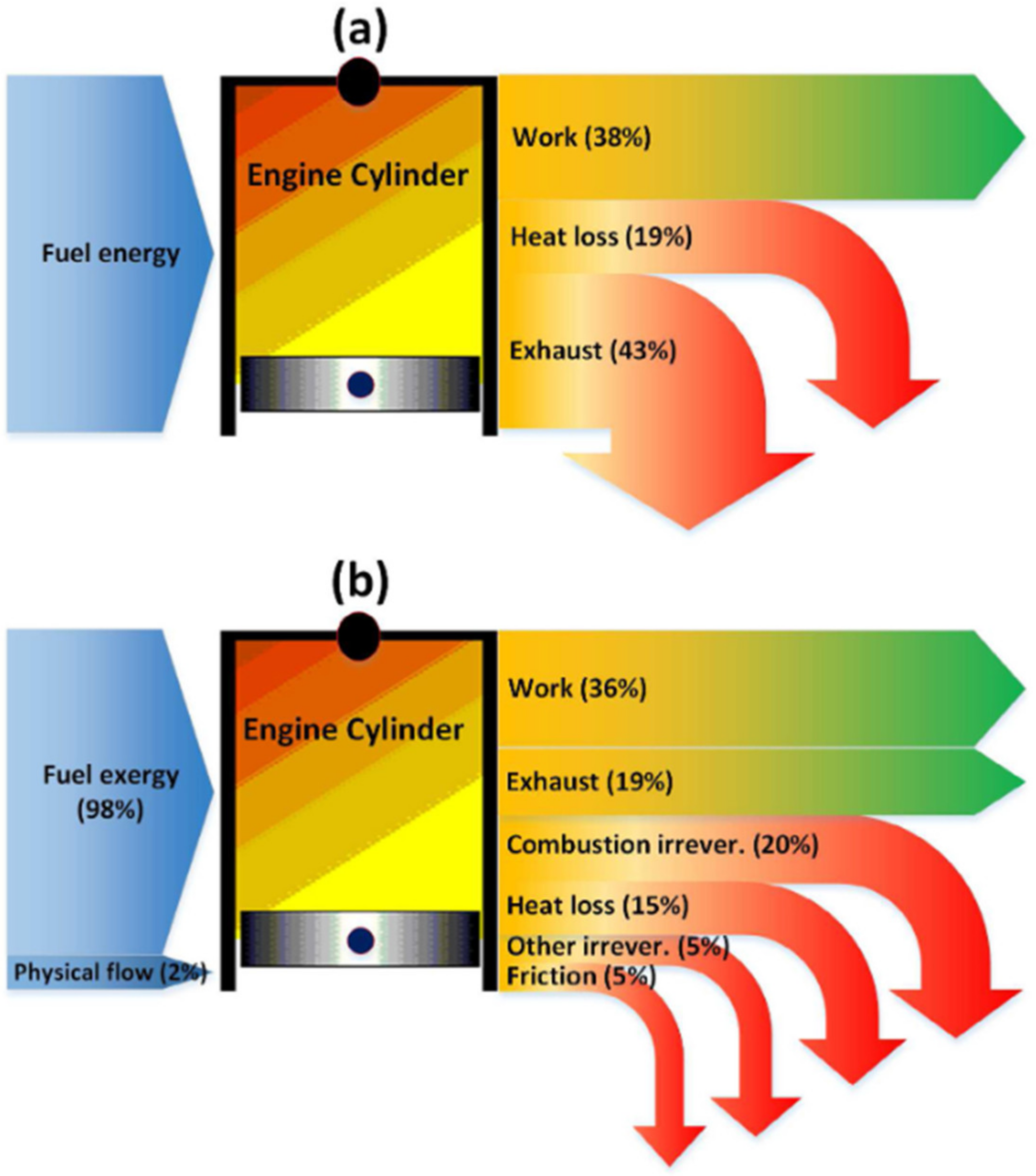
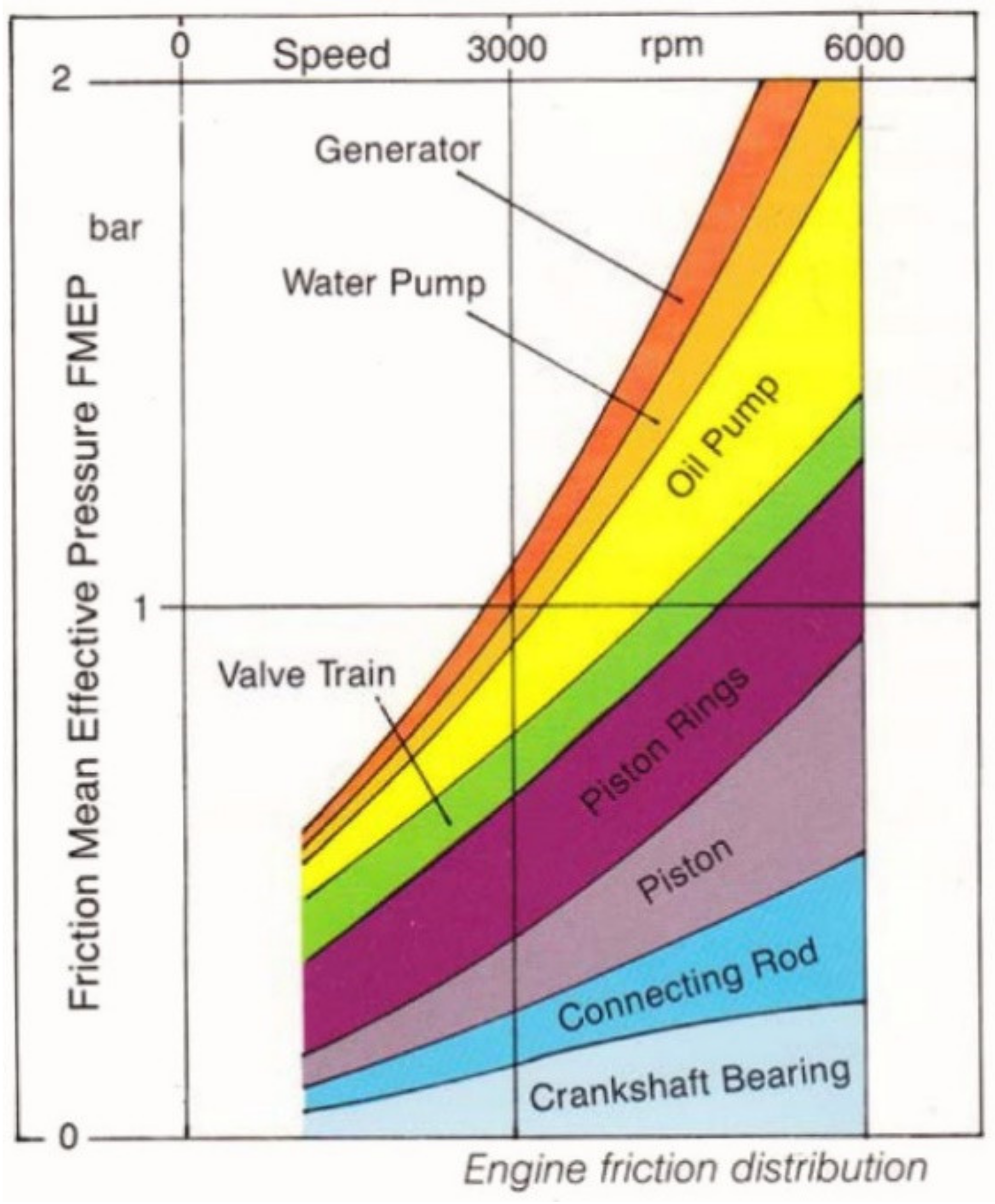
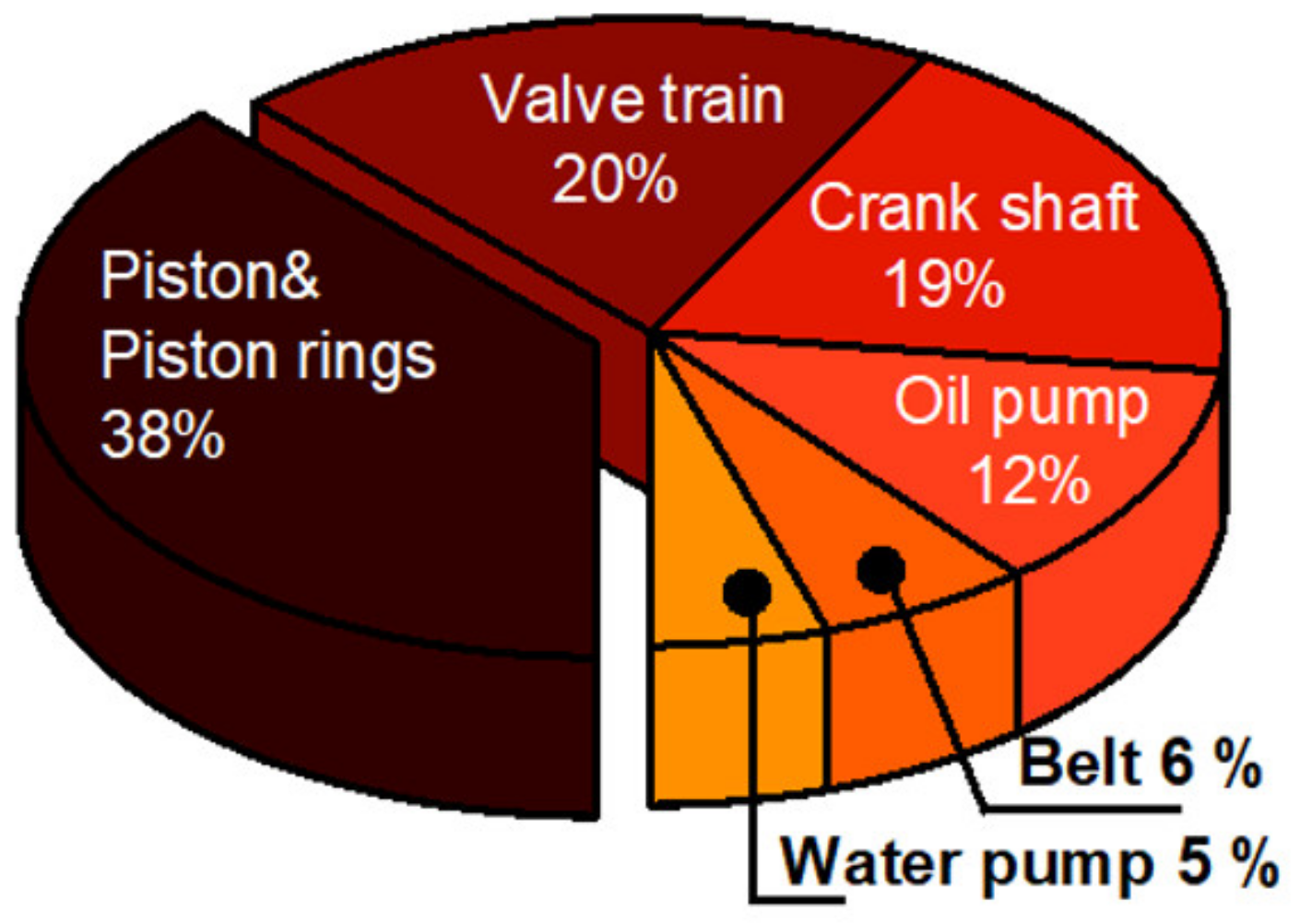
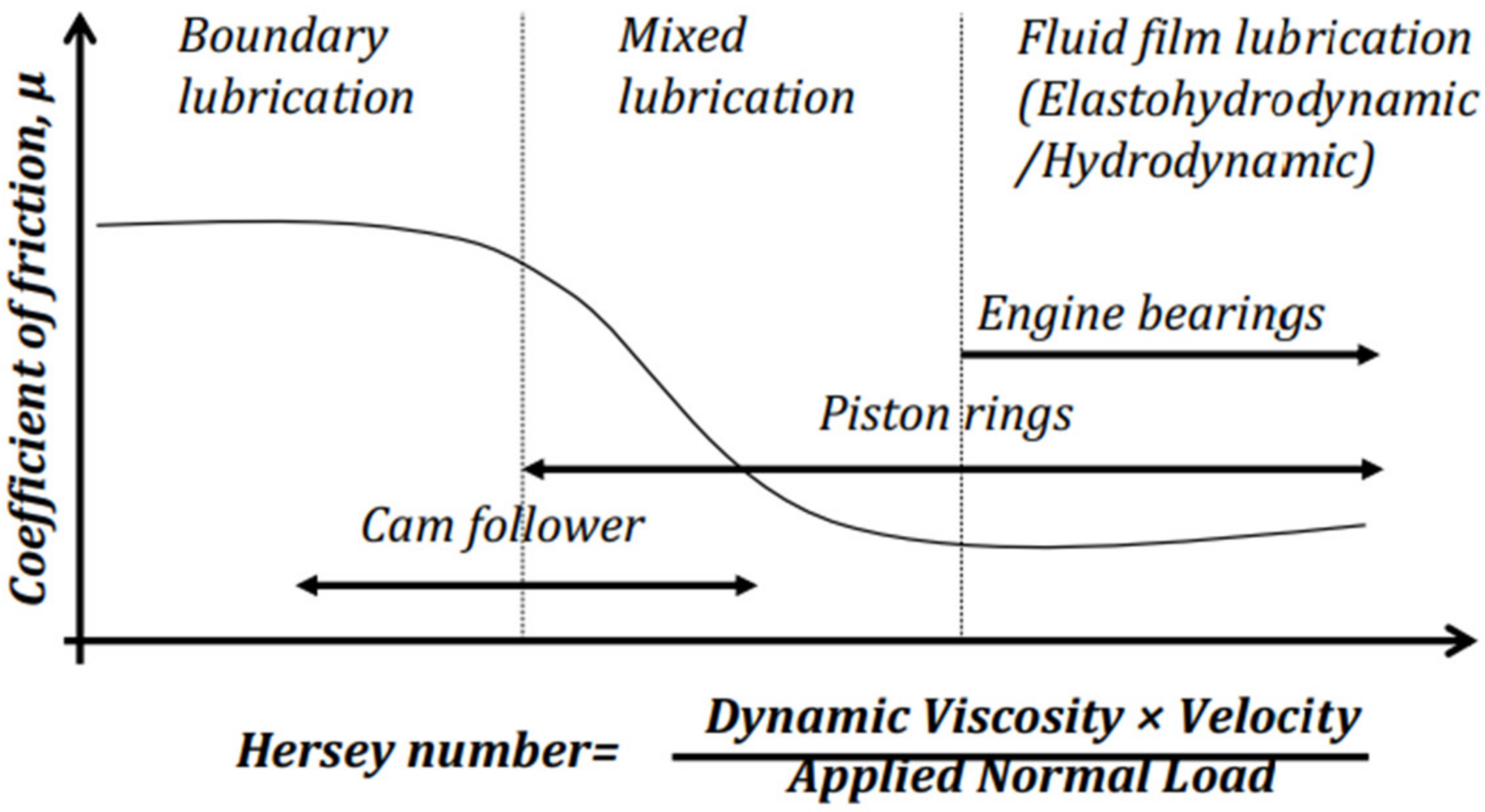

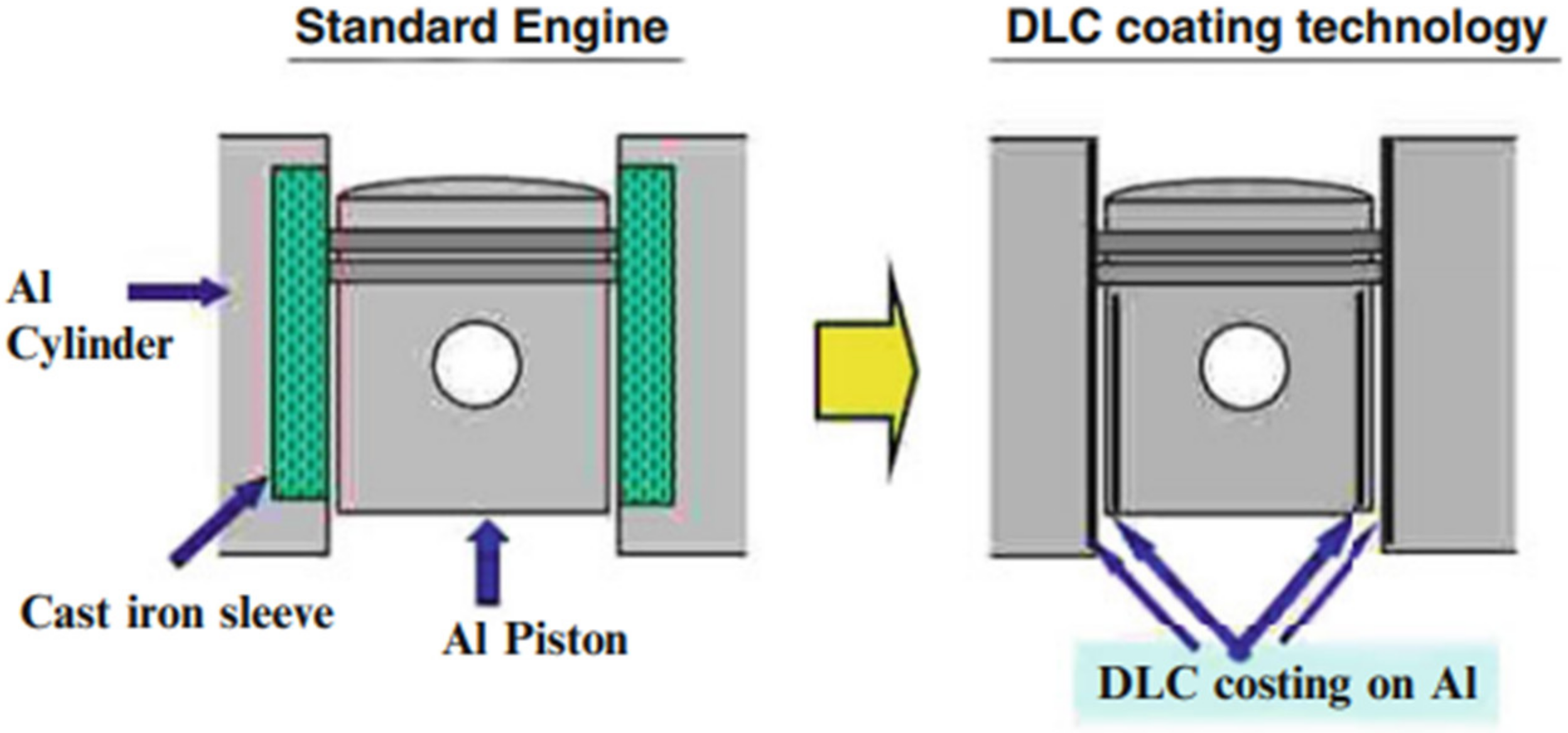
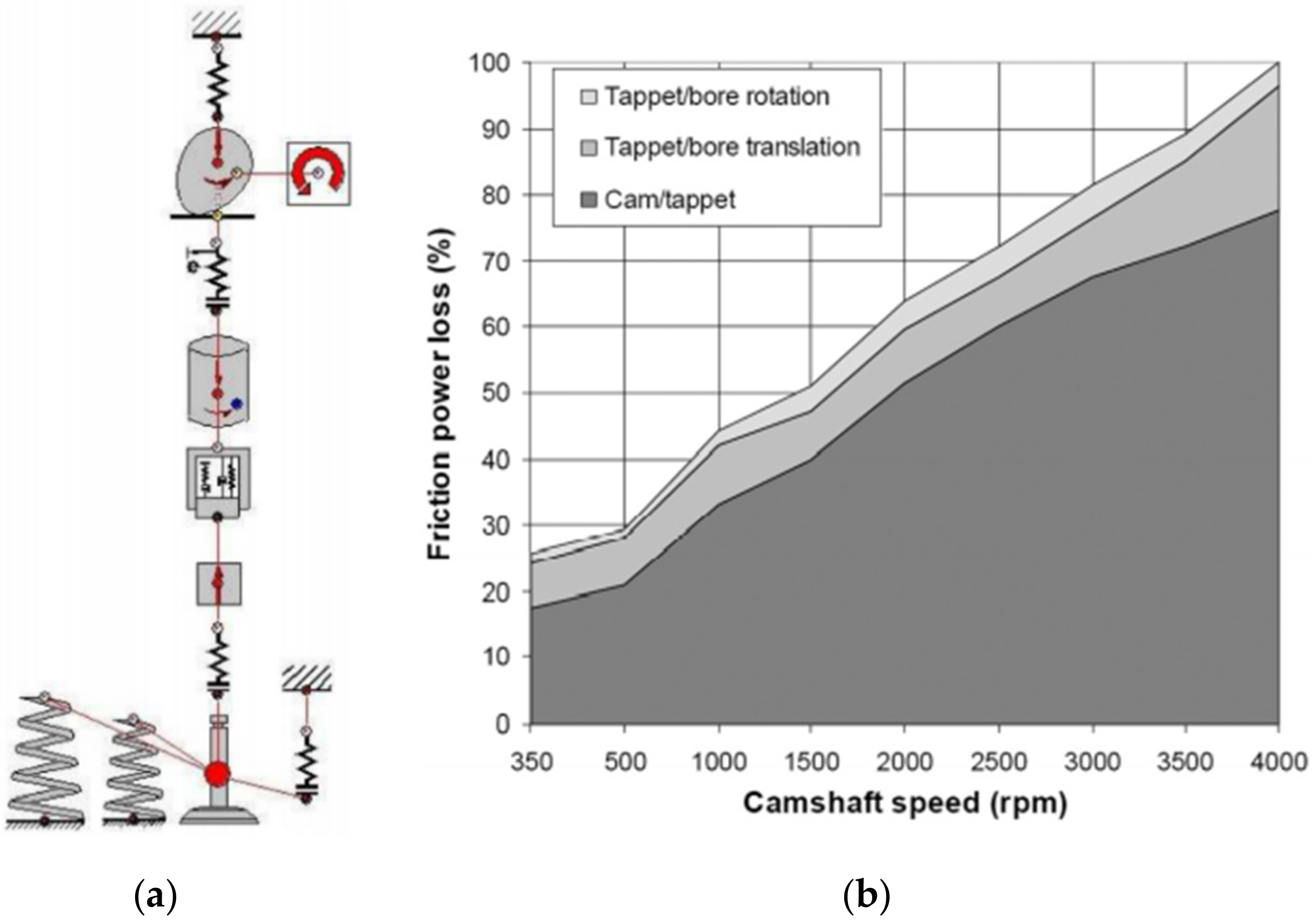
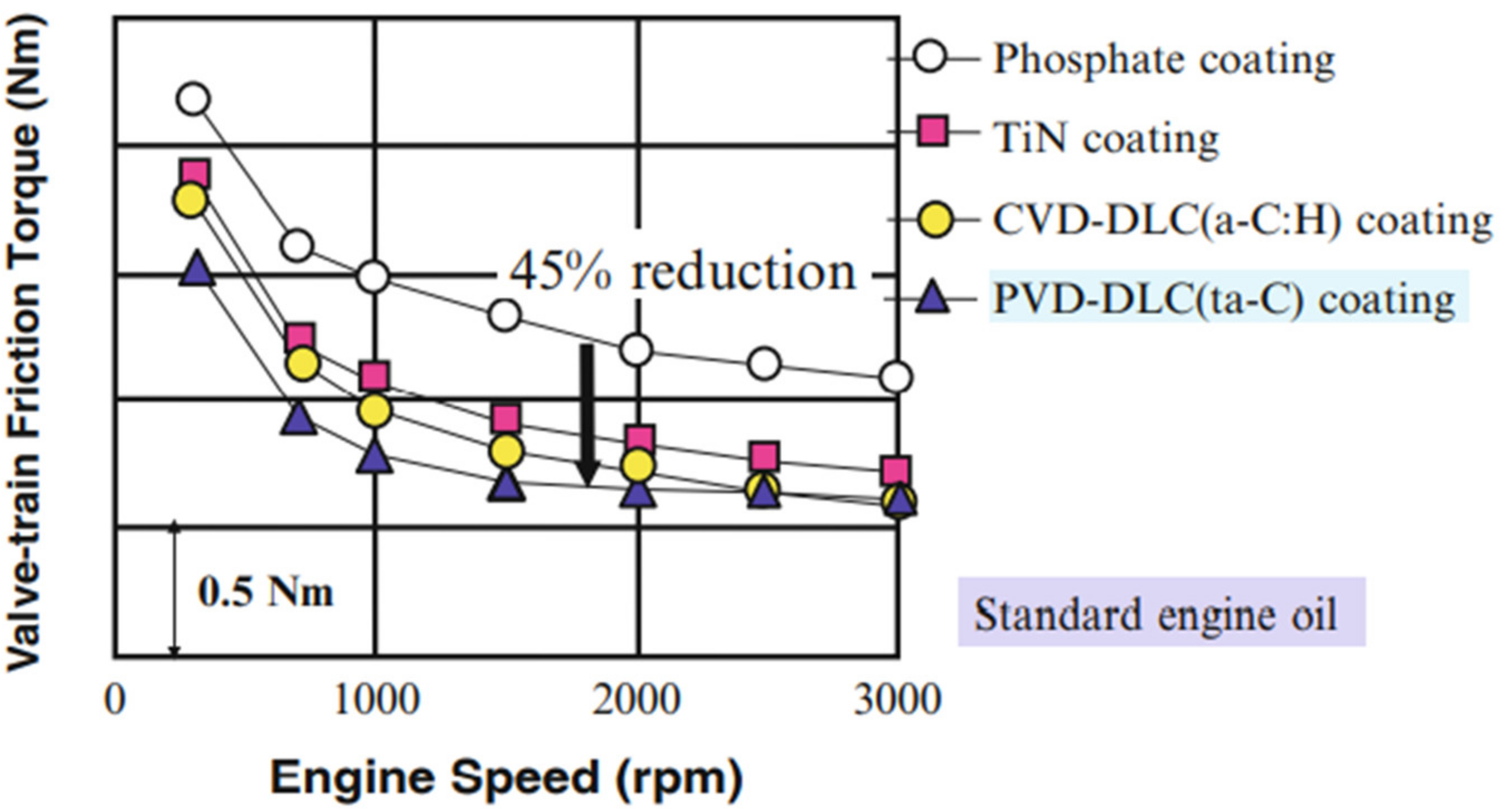
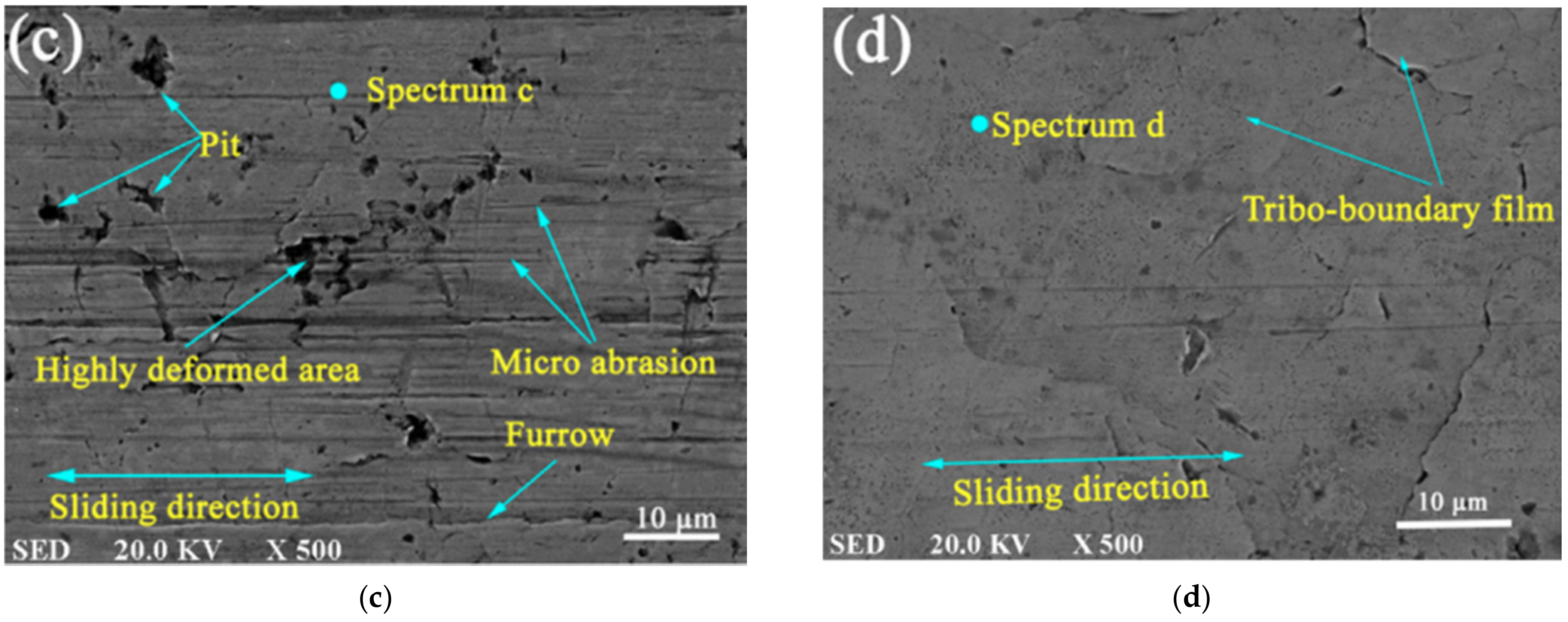



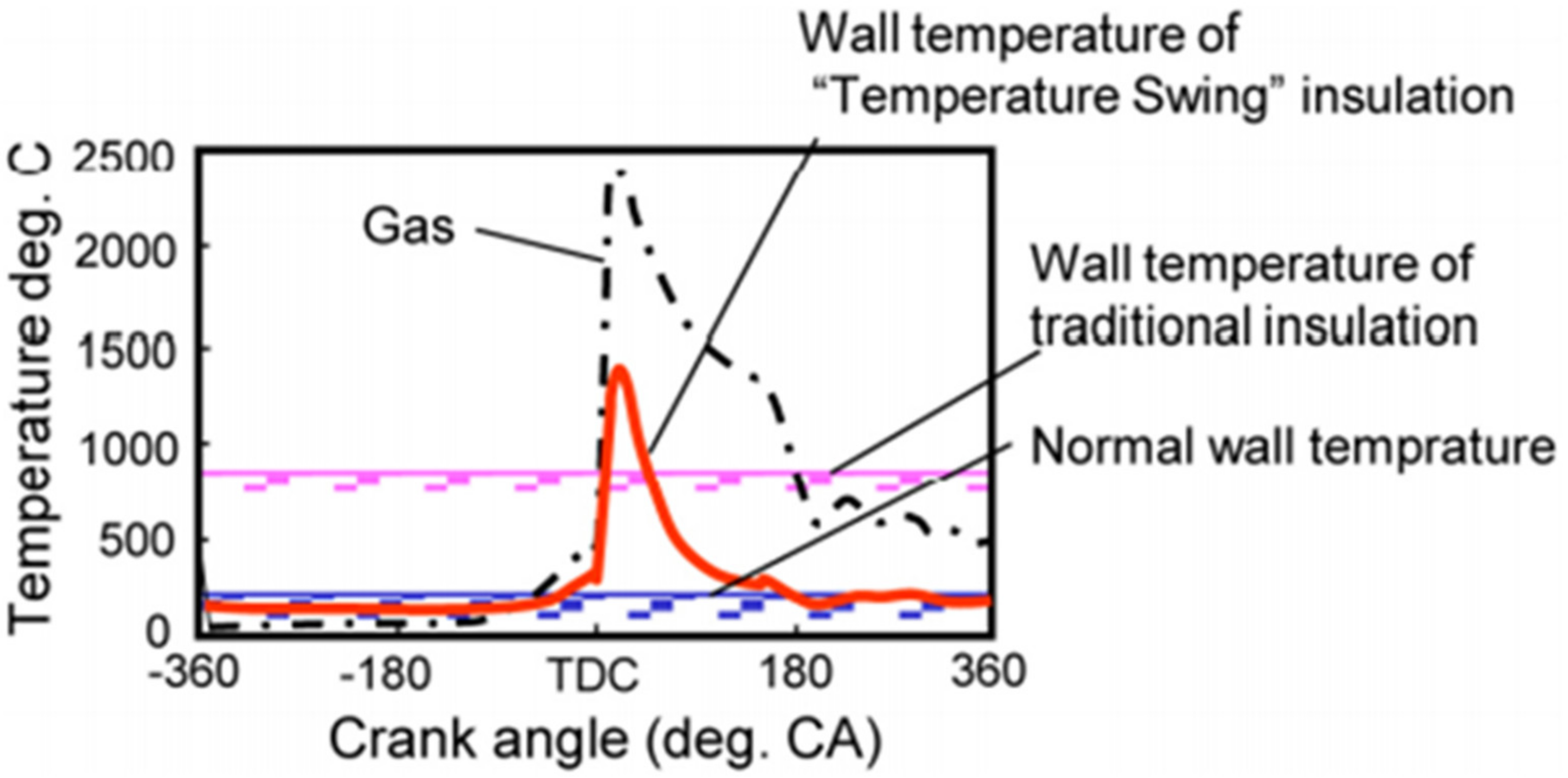
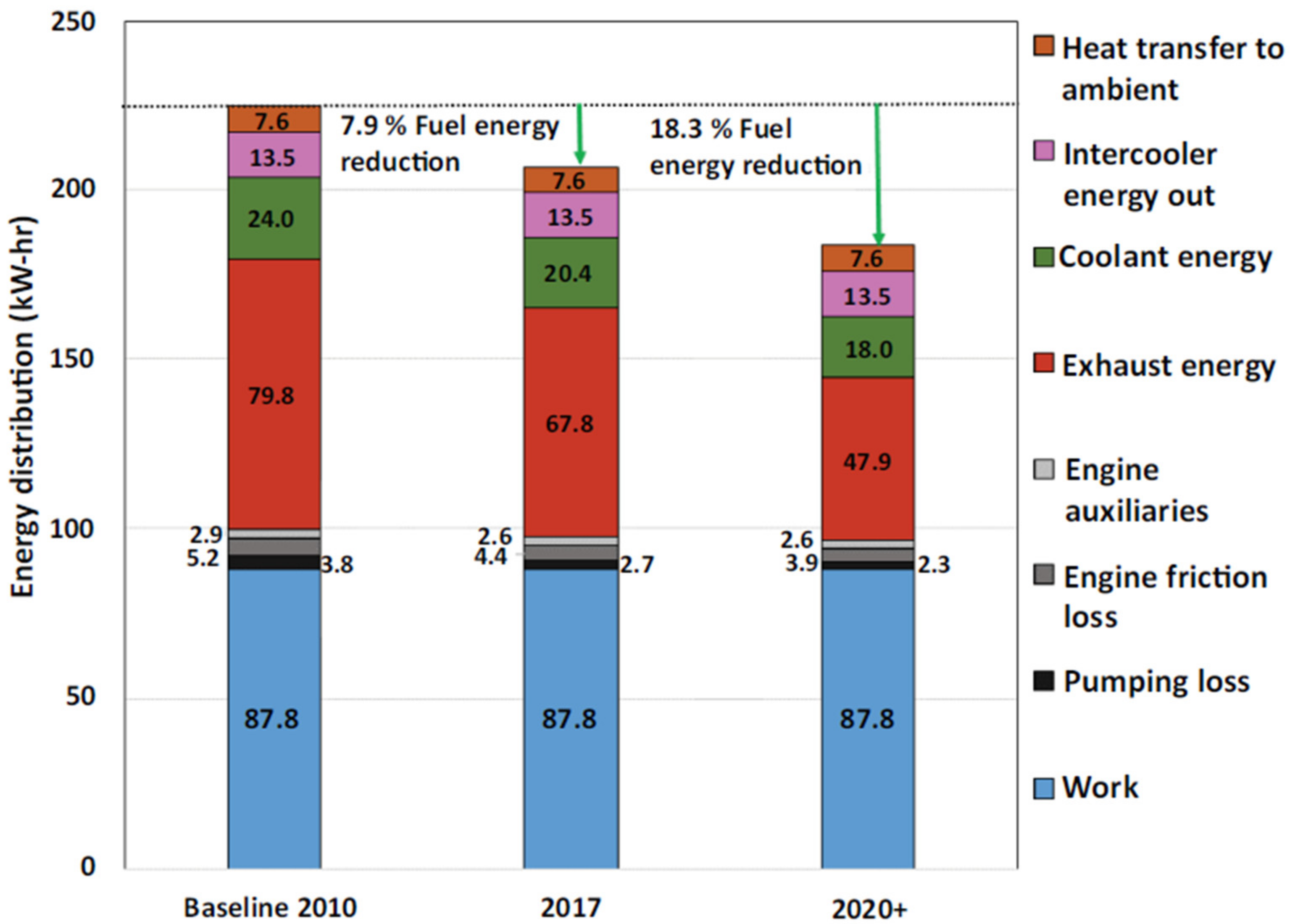
Publisher’s Note: MDPI stays neutral with regard to jurisdictional claims in published maps and institutional affiliations. |
© 2021 by the authors. Licensee MDPI, Basel, Switzerland. This article is an open access article distributed under the terms and conditions of the Creative Commons Attribution (CC BY) license (https://creativecommons.org/licenses/by/4.0/).
Share and Cite
Wang, Z.; Shuai, S.; Li, Z.; Yu, W. A Review of Energy Loss Reduction Technologies for Internal Combustion Engines to Improve Brake Thermal Efficiency. Energies 2021, 14, 6656. https://doi.org/10.3390/en14206656
Wang Z, Shuai S, Li Z, Yu W. A Review of Energy Loss Reduction Technologies for Internal Combustion Engines to Improve Brake Thermal Efficiency. Energies. 2021; 14(20):6656. https://doi.org/10.3390/en14206656
Chicago/Turabian StyleWang, Zhijian, Shijin Shuai, Zhijie Li, and Wenbin Yu. 2021. "A Review of Energy Loss Reduction Technologies for Internal Combustion Engines to Improve Brake Thermal Efficiency" Energies 14, no. 20: 6656. https://doi.org/10.3390/en14206656
APA StyleWang, Z., Shuai, S., Li, Z., & Yu, W. (2021). A Review of Energy Loss Reduction Technologies for Internal Combustion Engines to Improve Brake Thermal Efficiency. Energies, 14(20), 6656. https://doi.org/10.3390/en14206656





